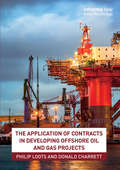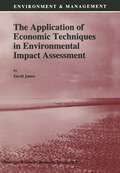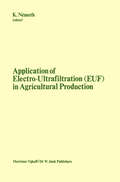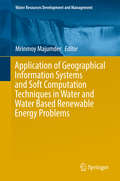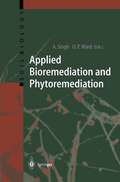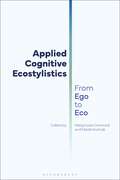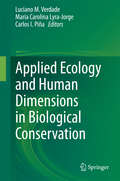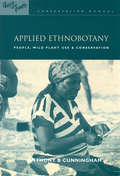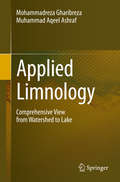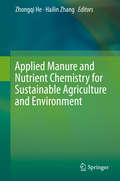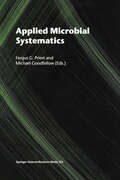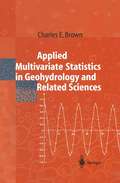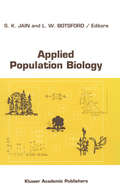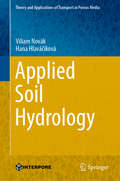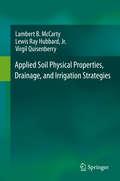- Table View
- List View
The Application of Contracts in Developing Offshore Oil and Gas Projects
by Philip Loots Donald CharrettThis book provides a comprehensive overview of the key aspects and contracts involved in the process of developing oil and gas projects, with an emphasis on offshore developments. Project development in oil and gas carries with it numerous unique risks and challenges. By identifying and managing risk through the various contract stages, each stage of the project is seen in perspective and therefore gives readers a better understanding of how that stage was arrived at and what is expected to come later. To do this, the authors use illustrative international case studies from past and current projects, thereby deepening the reader’s understanding and awareness of risk from practical experience, as well as suggesting answers for those who are involved in developing oil and gas projects. The Application of Contracts in Developing Offshore Oil and Gas Projects is intended for project owners, project managers, contractors, finance managers, commercial managers and lawyers who seek to understand the subject from a practical point of view.
The Application of Contracts in Developing Offshore Oil and Gas Projects
by Philip Loots Donald CharrettThis book provides a comprehensive overview of the key aspects and contracts involved in the process of developing oil and gas projects, with an emphasis on offshore developments. Project development in oil and gas carries with it numerous unique risks and challenges. By identifying and managing risk through the various contract stages, each stage of the project is seen in perspective and therefore gives readers a better understanding of how that stage was arrived at and what is expected to come later. To do this, the authors use illustrative international case studies from past and current projects, thereby deepening the reader’s understanding and awareness of risk from practical experience, as well as suggesting answers for those who are involved in developing oil and gas projects. The Application of Contracts in Developing Offshore Oil and Gas Projects is intended for project owners, project managers, contractors, finance managers, commercial managers and lawyers who seek to understand the subject from a practical point of view.
The Application of Economic Techniques in Environmental Impact Assessment (Environment & Management #4)
by David JamesThe contribution of economic thought and method to environmental management needs practical illustration. Too few books on the subject achieve such an outcome. This book is among the notable exceptions. That economics can provide a powerful vehicle for communicating an integrated understanding of the often diverse scientific findings germane to environmental im pact assessment needs to be illustrated convincingly. This book does just that. But it does more. It speaks across cultures: not to transfer know-how from one culture to another, but rather to activate an effective exchange of insights from one locale on the planet to another. As such, it is a genuine contribution to the great en vironmental exhortation of our times - think globally, act locally. Too often the people best placed to make such contributions are too committed to practical outcomes and making a living doing so. Just occasionally, however, they can be persuaded to make the special effort required to communicate globally. In this book, David James has once again orchestrated the contributions of vir tuoso performers. In doing so he has emulated the contribution he sustained throughout the International Drylands Project and preparation of the books written with John Dixon and Paul Sherman: The Economics ofDry/and Management and Case Studies in Dry/and Management (Earthscan, London). Taken together with his recent work as Special Commissioner for the path breaking national Forest and Timber Inquiry for the Australian Government, we have a body of work characterised by great worthiness, integrity and true global significance.
Application of Electro-Ultrafiltration (EUF) in Agricultural Production: Proceedings of the First International Symposium on the Application of Electro-Ultrafiltration in Agricultural Production, organized by the Hungarian Ministry of Agriculture and the Central Research Institute for Chemistry of the Hungarian Academy of Sciences, Budapest, May 610, 1980
by K. NémethThe Symposium was organized by the Hungarian Ministry of Agriculture and the Central Research Institute for Chemistry of the Hungarian Academy of Sciences. This arduous task was coordinated by Dr. Varju to whom I wish to express my appreciation for his whole-hearted assistance. After the Symposium the participants had the opportunity to visit the vineyards and cellars of the 'Balatonboglar' state holding which proved of great interest. The First International EUF Symposium owes its success to the excellent cooperation between the Biintehof Agricultural Research Station and the Hungarian Ministry of Agriculture, including the Central Research Institute for Chemistry of the Hungarian Academy of Sciences. The objective of the Symposium was to present the first results and experience gained with the EUF procedure, so that the papers delivered are only a survey of the present-day state of knowledge. The bulk of the work of editing, including the selection of the articles, fell on Prof. Dr. van Diest, Wageningen, for whose valuable advice and untiring efforts I wish to record my special thanks. Some of the papers presented at the Symposium have already been published elsewhere and they will not appear in this issue.
Application of Geographical Information Systems and Soft Computation Techniques in Water and Water Based Renewable Energy Problems (Water Resources Development and Management)
by Mrinmoy MajumderThis book highlights the application of Geographical Information System (GIS) and nature based algorithms to solve the problems of water and water based renewable energy resources. The irregularity in availability of resources and inefficiency in utilization of the available resources has reduced the potentiality of water and water based renewable energy resources. In recent years various soft computation methods (SCM) along with GIS were adopted to solve critical problems. The book collects various studies where many SCMs were used along with GIS to provide a solution for optimal utilization of natural resources for satisfying the basic needs of the population as well as fulfilling their burgeoning energy demands. The articles depict innovative application of soft computation techniques to identify the root cause and to mitigate the uncertainty for optimal utilization of the available water resources. The advantage of SCM and GIS were used to maximize the utilization of water resources under cost and time constraints in face of climatic abnormalities and effect of rapid urbanization.
Application of Nature Based Algorithm in Natural Resource Management
by Mrinmoy Majumder and Rabindra Nath BarmanThis book highlights the application of nature-based algorithms in natural resource management. The book includes the methodologies to apply what natural flora or fauna do to optimize their survival. The same technique was used to optimize renewable energy generation from water resources, maximization of profit from crop harvesting, forest resource management and decision-making studies. These studies can be used as an example for finding solutions of the other maximization or minimization problems which are common in natural resource management.
Application of Soil Physics in Environmental Analyses: Measuring, Modelling and Data Integration (Progress in Soil Science)
by Wenceslau Geraldes Teixeira Marcos Bacis Ceddia Marta Vasconcelos Ottoni Guilheme Kangussu DonnagemaThe importance to preserve soil and water have is increasingly recognized. Agricultural practices and ecological trends both affect and are affected by soil physical properties. The more frequency of natural disasters, as landslides and thunderstorms addresses the importance to integrate soil characteristics in predictive models. Soil physics research has grown considerably specially in the use of innovative sensors, soil databases, and modeling techniques have been introduced into soil water relationship and environmental monitoring. Those advances are thoroughly dispersed in articles and conference proceedings In this volume, the authors will bring together the effectiveness of many new field and lab sensors and examine the current state-of-the-art in modeling and data analysis. It also includes innovative approaches and case studies in tropical soils. Future directions in soil physics research are given by key researchers in this discipline.
Applications for Advancing Animal Ecology (Wildlife Management and Conservation)
by Michael L. Morrison Leonard A. Brennan Bruce G. Marcot William M. Block Kevin S. McKelveyPractical guidance for wildlife professionals working to improve study design, data analysis, and the application of results to habitat and population management.Despite major advances in sampling techniques and analytical methods, many animal ecologists conduct research that is primarily relevant to a specific time and place. They also tend to focus more on the statistical analyses and nuances of modeling than actual study design. Arguing that studies of animal ecology should always begin with a focus on the behaviors and characteristics of individual organisms, including how they form into distinct biological populations, Applications for Advancing Animal Ecology takes a fresh and critical look at the field. Building from its companion volume, Foundations for Advancing Animal Ecology, this practical book presents readers with the principal methods used to observe animal behavior. Teaching them to assess resource abundance categories of species-environmental relationships models, it also explores• major aspects of measuring animal habitat: what to measure and how to measure it;• common sampling and estimation methods to assess population parameters;• when to measure and how to analyze data;• problems that will confront ecologists in the coming years—and how to gather information to adequately address them; and• how the experimental approach can be used to advance the science of animal ecology.Throughout the book, the authors stress the importance of speaking a common and well-defined language. Avoiding vague and misleading terminology, they assert, will help ecologists translate science into meaningful and lasting actions in the environment. Taking the perspective of the organism of interest in developing concepts and applications, the authors always keep the potentially biased human perspective in focus. They also provide a selection of suggested research projects, cautions, and caveats. A major advancement in understanding the factors underlying wildlife–habitat relationships, Applications for Advancing Animal Ecology will be an invaluable resource to natural resource management professionals and practitioners, including state and federal agencies, non-governmental organizations, and environmental consultants.
Applications for Advancing Animal Ecology (Wildlife Management and Conservation)
by Michael L. Morrison Leonard A. Brennan Bruce G. Marcot William M. Block Kevin S. McKelveyPractical guidance for wildlife professionals working to improve study design, data analysis, and the application of results to habitat and population management.Despite major advances in sampling techniques and analytical methods, many animal ecologists conduct research that is primarily relevant to a specific time and place. They also tend to focus more on the statistical analyses and nuances of modeling than actual study design. Arguing that studies of animal ecology should always begin with a focus on the behaviors and characteristics of individual organisms, including how they form into distinct biological populations, Applications for Advancing Animal Ecology takes a fresh and critical look at the field. Building from its companion volume, Foundations for Advancing Animal Ecology, this practical book presents readers with the principal methods used to observe animal behavior. Teaching them to assess resource abundance categories of species-environmental relationships models, it also explores• major aspects of measuring animal habitat: what to measure and how to measure it;• common sampling and estimation methods to assess population parameters;• when to measure and how to analyze data;• problems that will confront ecologists in the coming years—and how to gather information to adequately address them; and• how the experimental approach can be used to advance the science of animal ecology.Throughout the book, the authors stress the importance of speaking a common and well-defined language. Avoiding vague and misleading terminology, they assert, will help ecologists translate science into meaningful and lasting actions in the environment. Taking the perspective of the organism of interest in developing concepts and applications, the authors always keep the potentially biased human perspective in focus. They also provide a selection of suggested research projects, cautions, and caveats. A major advancement in understanding the factors underlying wildlife–habitat relationships, Applications for Advancing Animal Ecology will be an invaluable resource to natural resource management professionals and practitioners, including state and federal agencies, non-governmental organizations, and environmental consultants.
Applications of Continuous and Steady-State Methods to Root Biology (Developments in Plant and Soil Sciences #34)
by John G. Torrey Lawrence J. WinshipThis book provides an excellent illustration of the interrelationship between progress in scientific methodology and conceptual advances, and its publica tion should contribute to further advances. It is well known that major advances in understanding often follow the development of new methods. The development of the acetylene reduction assay for nitrogenase activity provides a good example of this interrelationship between theory and methods. Theoretical knowledge led to a search for substrates for nitro genase that could be assayed for more easily than ammonium, the normal product of the enzyme. The discovery of the reduction of acetylene to ethylene by nitrogenase provided the ideal answer to the problem by provid ing a rapid, specific, nondestructive, and inexpensive assay for nitrogenase activity. This assay is now used by almost every laboratory doing research on nitrogen fixation. However, further use and development of the acetylene reduction assay has shown that it can underestimate nitrogenase activity and can even give incorrect relative values under some circumstances. The major problem is that exposure of legume nodules to acetylene can cause a large increase in the resistance to oxygen diffusion into the nodule. This reduced supply of oxygen decreases the rate of nitrogenase activity within a few minutes.
Applications of Furrow and Micro Irrigation in Arid and Semi-Arid Regions
by Megh R. GoyalApplications of Furrow and Micro Irrigation in Arid and Semi-Arid Regions, the fifth volume in the Research Advances in Sustainable Micro Irrigation series, addresses the ever-challenging need for irrigation systems in arid and semi-arid regions of the world, areas that are suffering from severe water shortages. These areas, such as Egypt, Tunisia,
Applied Bioremediation and Phytoremediation (Soil Biology #1)
by Ajay SinghThe huge expansion of the chemical and petroleum industries in the twentieth century has resulted in the production of a vast array of chem ical compounds and materials that have transformed our lives. The associated large-scale manufacturing, processing and handling activi ties have caused a serious deterioration in environmental quality and created threats to human health. These negative impacts have led to responses and regulations requiring remedial action in support of envi ronmental sustainability. of biotechnological methods through bioremediation, Application has gained prominence as an option for soil remediation methods. Bioremediation is a multidisciplinary approach where biologists, chem ists, soil scientists and engineers work as team to develop and imple ment remediation processes. Bioremediation has now been used successfully to remediate many petroleum-contaminated sites. However, there are as yet no commercial technologies commonly used to reme diate the most recalcitrant contaminants. Nevertheless, bioremediation is a rapidly advancing field and new bio-based remedial technologies are continuing to emerge.
Applied Cognitive Ecostylistics: From Ego to Eco
by Malgorzata Drewniok, Marek Kuźniak, andThis book offers an up-to-date account of one of the most influential strands of eco-research: cognitive ecostylistics. The onset of the 1970s saw a global shift in scholarly perspective upon the relation between egocentric and ecocentric views of the world. The so-called eco-turn was not only linguistic at its roots, but engaged the bulk of academic thought in social sciences and humanities. Cognitive ecostylistics invites a multidisciplinary approach to the study of the conceptual relations between oral or written texts and their impact on the environment. This volume is a collection of the latest research that seeks to apply the theory and methodology developed over the last 40 years to both literary and real-life texts, engaging with a wealth of examples from First World War poetry and Anne of Green Gables through to Condé Nast Traveller hotel descriptions. Exploring the cultural effects of the eco-turn, the collection engages the reader in the problem of the present-day Anthropocene, manifested as Ego-Eco tensions at the level of communicating self-needs and the needs of the Other. Divided into two parts, it considers first the human-angled semiotic interplay contained within the universe of people, before examining the problem of semiotic engagement of texts as extraneous to the human, highlighting crucial aspects of nature, culture, and beyond.
Applied Cognitive Ecostylistics: From Ego to Eco
This book offers an up-to-date account of one of the most influential strands of eco-research: cognitive ecostylistics. The onset of the 1970s saw a global shift in scholarly perspective upon the relation between egocentric and ecocentric views of the world. The so-called eco-turn was not only linguistic at its roots, but engaged the bulk of academic thought in social sciences and humanities. Cognitive ecostylistics invites a multidisciplinary approach to the study of the conceptual relations between oral or written texts and their impact on the environment. This volume is a collection of the latest research that seeks to apply the theory and methodology developed over the last 40 years to both literary and real-life texts, engaging with a wealth of examples from First World War poetry and Anne of Green Gables through to Condé Nast Traveller hotel descriptions. Exploring the cultural effects of the eco-turn, the collection engages the reader in the problem of the present-day Anthropocene, manifested as Ego-Eco tensions at the level of communicating self-needs and the needs of the Other. Divided into two parts, it considers first the human-angled semiotic interplay contained within the universe of people, before examining the problem of semiotic engagement of texts as extraneous to the human, highlighting crucial aspects of nature, culture, and beyond.
Applied Ecology and Human Dimensions in Biological Conservation
by Luciano M. Verdade Maria Carolina Lyra-Jorge Carlos I. PiñaThis book provides both the conceptual basis and technological tools that are necessary to identify and solve problems related to biodiversity governance. The authors discuss intriguing evolutionary questions, which involve the sometimes surprising adaptive capacity of certain organisms to dwell in altered and/or changing environments that apparently lost most of their structure and functionality. Space and time heterogeneities are considered in order to understand the patterns of distribution and abundance of species and the various processes that mold them. The book also discusses at which level—from genes to the landscape, including individuals, populations, communities, and ecosystems—men should intervene in nature in order to prevent the loss of biodiversity.
Applied Ethnobotany: People, Wild Plant Use and Conservation (People and Plants International Conservation)
by Anthony B CunninghamIts wise and sensitive approach to working with local people will be relevant in situations throughout the world.' ECOS 'The numerous diagrams, tables of data, information flow charts, fieldwork sketches etc. give a great vibrancy to the work... It deserves a wide readership.' TEG News Wild or non-cultivated plants are crucial to the lives of a large portion of the world's population, providing low-cost building materials, fuel, food supplements, medicines, tools and sources of income. Despite their importance, their vulnerability to harvesting and other social impacts is not well understood. Applied Ethnobotany is the first practical guide to be published on how to manage wild plant species sustainably. This detailed manual on wild plant resources sets out the approaches and field methods involved in participatory work between conservationists, researchers and the primary resource users. Supported by extensive illustrations, it explains how local people can learn to assess the pressures on plant resources and what steps to take to ensure their continued availability. For all those involved in resource management decisions regarding plant species and diversity, and in particular those studying or working in conservation, rural development and park management, this guide is invaluable. Published with WWF, UNESCO and Royal Botanic Gardens Kew
Applied Ethnobotany: People, Wild Plant Use and Conservation (People and Plants International Conservation)
by Anthony B. CunninghamIts wise and sensitive approach to working with local people will be relevant in situations throughout the world.' ECOS 'The numerous diagrams, tables of data, information flow charts, fieldwork sketches etc. give a great vibrancy to the work... It deserves a wide readership.' TEG News Wild or non-cultivated plants are crucial to the lives of a large portion of the world's population, providing low-cost building materials, fuel, food supplements, medicines, tools and sources of income. Despite their importance, their vulnerability to harvesting and other social impacts is not well understood. Applied Ethnobotany is the first practical guide to be published on how to manage wild plant species sustainably. This detailed manual on wild plant resources sets out the approaches and field methods involved in participatory work between conservationists, researchers and the primary resource users. Supported by extensive illustrations, it explains how local people can learn to assess the pressures on plant resources and what steps to take to ensure their continued availability. For all those involved in resource management decisions regarding plant species and diversity, and in particular those studying or working in conservation, rural development and park management, this guide is invaluable. Published with WWF, UNESCO and Royal Botanic Gardens Kew
Applied Hydrogeophysics (Nato Science Series: IV: #71)
by Harry Vereecken Andrew Binley Giorgio Cassiani André Revil Konstantin TitovThis book focuses on the the application of hydrogeophysical methods to the understanding of hydrological processes and environmental problems dealing with the flow of water and the transport of solutes and contaminants. Taking a process-driven approach, the book offers a series of process-driven chapters, each authored by leading experts. Areas covered include: infiltration and solute transport processes, biogeochemical functioning of soil-water systems, coastal groundwater interactions, cold region hydrology, engineered barriers and landfill processes.
Applied Limnology: Comprehensive View from Watershed to Lake
by Mohammadreza Gharibreza Muhammad Aqeel AshrafA multidisciplinary study of Bera Lake in Malaysia is presented here, focusing on natural resources throughout the lake’s catchment area and assessing environmental impact. This applied limnology study examines issues relating to land development including soil erosion and nutrient loss in the catchment area, severe pollution of water, sediment resources in open waters and wetlands, and reduction of aquatic and bird populations. The chapters provide a comprehensive view of problems, risks and possible mitigation measures associated with this great natural habitat. The book highlights the technology and methods used to estimate both soil erosion rate and nutrient loss from the lake catchment, including an explanation of the measurement of the sedimentation rate in Bera Lake using 137Cs and 210Pb radioisotopes. The author examines the current and historic situation of contamination in sediments, presents an ecological risk assessment, and finally describes a master management plan, proposing practices to mitigate the environmental impacts of existing agricultural projects and practices to control future projects. Readers will learn of a decrease in the watershed supply of water to Bera Lake, of shoaling, degradation of water and sediment quality, and the extinction of several kinds of flora and fauna. This volume also offers an approach to sustainable land use with regard to natural resources conservation.
Applied Manure and Nutrient Chemistry for Sustainable Agriculture and Environment
by Zhongqi He Hailin ZhangDue to the rapid increase in world population and improving living standards, the global agriculture sector is confronting with challenges for the sustainability of agricultural production and of the environment. Intensive high-yield agriculture is typically dependent on addition of fertilizers (synthetic chemicals, animal manure, etc.). However, non-point nutrient losses from agricultural fields due to fertilization could adversely impact the environment. Increased knowledge on plant nutrient chemistry is required for improving utilization efficiency and minimizing loses from both inorganic and organic nutrient sources. For this purpose, the book is composed of 19 chapters that highlight recent research activities in applied nutrient chemistry geared toward sustainable agriculture and environment. Topics of interest include, but are not limited, to speciation, quantification, and interactions of various plant nutrients and relevant contributories in manure, soil, and plants. This book outlooks emerging researchable issues on alternative utilization and environmental monitoring of manure and other agricultural by products that may stimulate new research ideas and direction in the relevant fields.
Applied Microbial Systematics
by F. G. Priest Michael GoodfellowModern approaches to microbial classification and identification, particularly those based on nucleic acid analysis, have raised the awareness and interest of microbiologists in systematics during the past decade. The extended scope of the subject has revolutionized microbial ecology with the demonstration of uncultivable microorganisms as a major component of the biosphere and evolution, with the ribosomal RNA phylogenetic tree as the basis of current classifications. However, advances in microbial systematics have also had enormous impact on other, diverse aspects of microbiology such as animal pathogenicity, plant-microbe interactions and relationships with food. In this book, we survey and discuss in depth the contribution of modern taxonomic approaches to our understanding of the microbiology of these various systems. The book does not concentrate on methods - these have been well reported elsewhere - instead it provides a unique insight into the application and value of modern systematics in diverse branches of microbiology. It will be of value to microbiologists at both research and technical levels who need to appreciate the range of organisms with which they work and the diversity within them. It will also be of value to teachers and students of microbiology courses who want to understand how systematics can enhance microbiology beyond the routine of classification, nomenclature, and identification.
Applied Multivariate Statistics in Geohydrology and Related Sciences
by Charles E. BrownIt has been evident from many years of research work in the geohydrologic sciences that a summary of relevant past work, present work, and needed future work in multivariate statistics with geohydrologic applications is not only desirable, but is necessary. This book is intended to serve a broad scientific audience, but more specifi cally is geared toward scientists doing studies in geohydrology and related geo sciences.lts objective is to address both introductory and advanced concepts and applications of the multivariate procedures in use today. Some of the procedures are classical in scope but others are on the forefront of statistical science and have received limited use in geohydrology or related sciences. The past three decades have seen a significant jump in the application of new research methodologies that focus on analyzing large databases. With more general applications being developed by statisticians in various disciplines, multivariate quantitative procedures are evolving for better scientific applica tion at a rapid rate and now provide for quick and informative analyses of large datasets. The procedures include a family of statistical research methods that are alternatively called "multivariate analysis" or "multivariate statistical methods".
Applied Population Biology (Monographiae Biologicae #67)
by S. K. Jain L. W. BotsfordAn increasing variety of biological problems involving resource management, conservation and environmental quality have been dealt with using the principles of population biology (defined to include population dynamics, genetics and certain aspects of community ecology). There appears to be a mixed record of successes and failures and almost no critical synthesis or reviews that have attempted to discuss the reasons and ways in which population biology, with its remarkable theoretical as well as experimental advances, could find more useful application in agriculture, forestry, fishery, medicine and resource and environmental management. This book provides examples of state-of-the-art applications by a distinguished group of researchers in several fields. The diversity of topics richly illustrates the scientific and economic breadth of their discussions as well as epistemological and comparative analyses by the authors and editors. Several principles and common themes are emphasized and both strengths and potential sources of uncertainty in applications are discussed. This volume will hopefully stimulate new interdisciplinary avenues of problem-solving research.
Applied Soil Hydrology (Theory and Applications of Transport in Porous Media #32)
by Viliam Novák Hana HlaváčikováThis state-of-the-art book clearly explains the basic principles of soil hydrology and the current knowledge in this field. It particularly highlights the estimation and application of measurements and evaluation of soil-hydrophysical characteristics using simulation models, with a focus on elucidating the basic hydrophysical characteristics of soil, such as soil water potential and hydraulic conductivity, as well as the methods of measurement. It also addresses topics such as stony soil, water repellent soils, and water movement modeling in those media. The book presents soil hydrology in a simple way, while quantitatively expressing the soil water state and movement. It clearly and precisely describes basic terms of soil hydrology with a minimum of mathematics. It also includes the latest research findings in the field as well as the basics of the mathematical modeling of water movement in the soil-plant-atmosphere system (SPAS), using original research results to illustrate these issues.This book is of interest to all scientists and professionals in soil hydrology, including beginners, as well as those interested and working in hydrology in general and soil hydrology in particular. In addition, it can also be used by specialists and students in related fields like agronomy, forestry, meteorology, hydrology, environmental engineering, environmental protection, and geography.
Applied Soil Physical Properties, Drainage, and Irrigation Strategies.
by Lambert B. McCarty Lewis Ray Hubbard, Jr. Virgil QuisenberryThe book is a realistic blend of basic knowledge and understanding in soil physical properties. It will enable the reader to scientifically analyze soils to develop practical and successful means of providing sufficient drainage and to develop science-based irrigation strategies. Only basic mathematical knowledge is necessary to understand and apply the proven principles covered. With limited resources that are increasing significantly in costs, the book blends the ideal concept of providing sufficient drainage and irrigation based on using soil physical properties but with financial limitations in mind. One traditional problem with many Soil Physics, Drainage, and Irrigations-based texts is the prerequisite of understanding complicated calculus-based mathematics. Although necessary for a theory-based text, our text was developed with practitioners in mind where such complicated mathematics was avoided but referenced if the reader wishes to further explore the specific topic. Another problem with many traditional texts is the lack of practical examples or case-studies allowing readers to relate their specific scenarios to similar types of situations. We have purposely included numerous examples and practical field experiences. This is especially true when many of the theoretical ideals are covered, followed by explanations of how such ideals can be applied in the laboratory and field.
